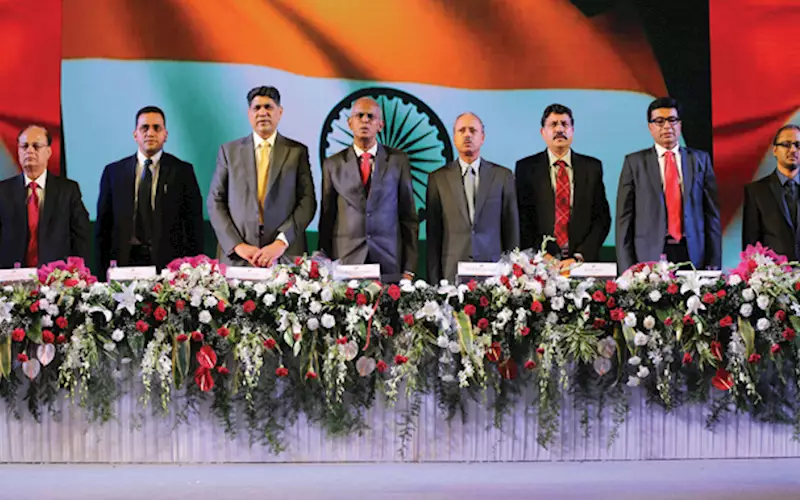Indian paper mills will produce 20 million tonnes in 2020 and 27 million tonnes by 2030
The 55th AGM and Conference of the Federation of Paper Traders Association hosted its magnum opus celebration at the Grand Hyatt, Mumbai. The event which was attended by more than 800 paper traders across India saw JK Paper’s vice chairman and managing director Harsh Pati Singhania address the gathering as the chief guest at the conference.
17 Oct 2016 | By PrintWeek India
Singhania was quite unequivocal that India is the fastest growing paper market globally. He said, the Indian paper industry is growing at over 7% and projected to grow at over 4% per annum till 2030. This is translated into 20 million tonnes in 2020 and 27 million tonnes by 2030.
He reassured the audience that the Indian paper mill industry has made suitable investments to cope with the demand. He said, the Indian paper mills have invested over Rs 20,000 crore in the last five years. But it needs investments of Rs 90,000 crore to add new capacities by 2030.
He said, digital India is not a threat to the paper industry but an opportunity due to the additional usage of paper and paper materials. He added, the paper industry has huge potential to grow as the per capita consumption of India is only 11 kgs as compared to 26 kgs in Asia and 56 kgs globally.
Today, the Rs 50,000 crore paper industry in India provides employment to four lakh people directly and 15 lakh people indirectly, Singhania said.
Demand for better quality packaging of FMCG products marketed through organised retail, rising healthcare spends, over-the-counter medicines and increasing preference for ready-to-eat foods are the key demand drivers for paperboard.
Singhania gave the government programs a thumbs up. He felt the ‘Make in India’ project by the government of India will boost the demand for packaging.
The market for writing and printing paper is expected to grow by about 6% annually over the next five years. As a result, market for printing and writing paper will expand from the current 4.8 million tonnes in 2015-16 to about 5.8 million tonnes per year by 2018-19.
JK Paper has invested Rs 2,000 crore in its paper business and has a combined capacity of 4.5 lakh tonnes across its two plants in Odisha and Gujarat. There is market speculation about the acquisition of two factories of Avantha Group firm BILT Graphic Paper Products. This should help JK Paper leapfrog if it happens.
Today, the growth driver for packaging board indicates a healthy 15 per cent growth per annum. In 2015, the industry saw the entry of two new players in packaging board. These were: Emami with a capacity of 150,000 MT and TNPL with 200,000 MT. The overall industry, including paper and board, will surpass 20 MT by 2020 from the current size of 15 MT.
In this sense, Singhania mentioned a recent visit to Brazil to study the paper mills and the technology and processes in that country. He expressed his concern about the price of wood, which is the main raw material for paper industry. He felt, this is higher in India compared to most other countries and emphasised on the need of favourable policies for plantations.
He pointed out that the current wood requirement of the Indian paper industry is 10-MT against availability of 9-MT. The scenario is likely to improve in next two-three years because of extensive plantations done by the industry by way of social farm forestry, Singhania said.

(c) Singhania at the event
He said that paper companies have achieved a turnaround as costs have come down. But he cautioned that competition from import has continued and pricing of paper has to be competitive to landed cost of paper. Interestingly enough, JK has started outsourcing paper to sell under its own brand but the share of such paper is not big.
Commenting on JK Paper’s performance, Singhania said the company has increased capacity to 4.55 lakh tonne per annum after investment of Rs 2,000 crore.
The company recorded 15% growth in gross revenue at Rs 3,000 crore in 2015-16 and hopes to continue the double digit growth.
For seeking raw material security, JK Paper is looking at investment in plantations in Myanmar. The company has already commenced a pilot plantation project in Myanmar and is looking at other neighbouring and African countries for plantation to secure raw material, Singhania added.
Singhania mentioned that going ahead, the company would look at developing plantations in other countries as well.
"The improvement in performance is mainly due to higher production and sales, enriched product mix, continuous improvements in operating efficiencies and input cost reduction in comparison with corresponding quarter," concluded Singhania.
On the sidelines of the Federation of Paper Traders Association, Sriram Selvam spoke to six paper traders in India. These are: Hasit Shah of Chimanlal Fein Paper, Siddharth Bang of Bang Paper, Nimesh Vora of Srinivas Papers, Deepak Mittal of Kar Paper, A Venkat Annamalai of Jeyam & Company and Sagar Java of CH Java.











 See All
See All